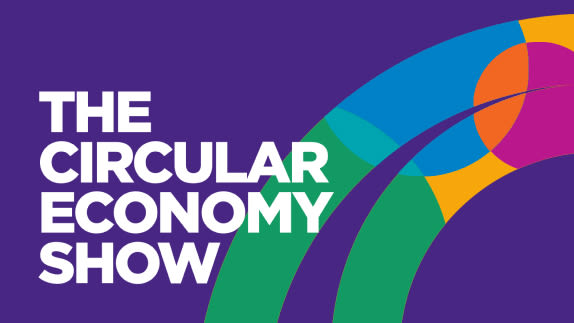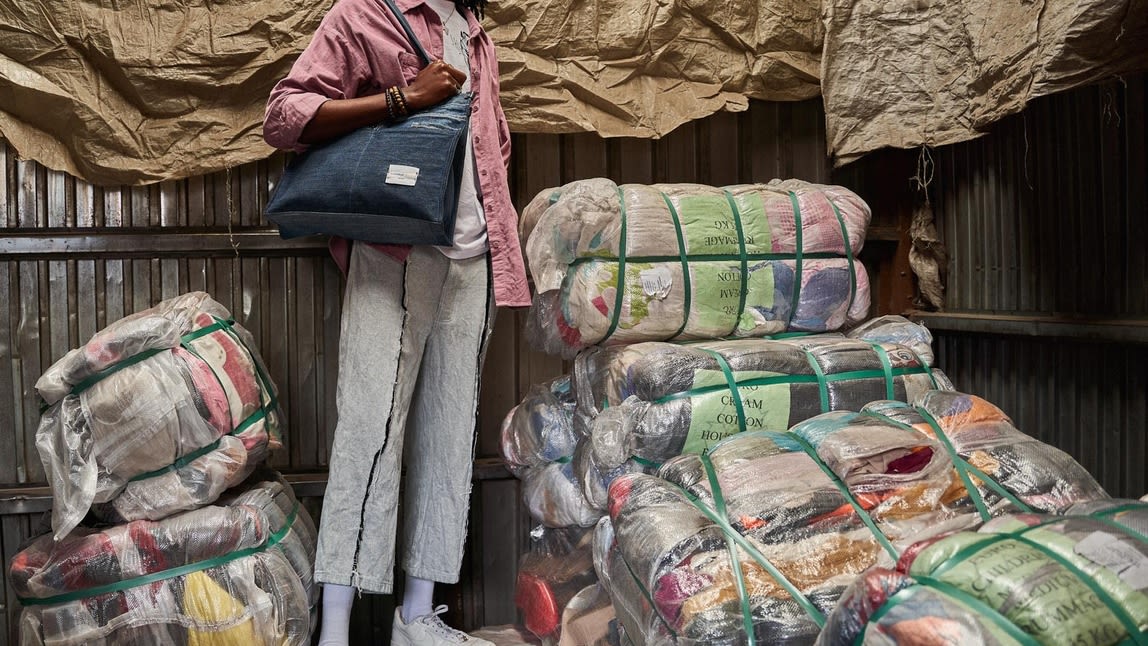How do we shift today’s economic system to one that helps to regenerate nature? In this episode we’ll meet three companies developing materials that work in harmony with our environment, and learn how such innovations can be scaled.
Co-founder of Materiom, Liz Corbin, spoke to her fellow co-founder Alysia Garmulewicz, Julia Marsh from Sway and Ehab Sayed from Biohm, at the Ellen MacArthur Foundation’s Innovation Day in 2022.
Your feedback helps us reach more people interested in the circular economy, please leave us a review!
Listen on Spotify, Apple Podcasts, or wherever you get your podcast.
Click to expand
Pippa Shawley 00:02
It's no secret that we need to rethink how our economy operates. We need an economy that not only restores, but actively improves the world we live in. One that is regenerative by design. Welcome to the Circular Economy show. I'm Pippa. In this episode, we're circling back to a conversation that shone the spotlight on some of the most exciting innovations in the circular economy. We'll hear about where that innovation is already happening, its impact and how it can scale successfully. I'm taking you back to the Ellen MacArthur Foundation's Innovation Day event at London's Roundhouse in 2022. Materiom's co-founder, Liz Corbin, sat down with her fellow co-founder Alysia Garmulewicz, Julia Marsh, co-CEO from Sway, and Ehab Sayed, from Biohm, to explore how they're developing regenerative materials. Liz began by asking her guests to introduce what they do.
Liz Corbin 00:54
So this is often clouded as the third principle of Ellen MacArthur Foundation's definition of a circular economy. But I'm here to ask you all, how do we really start to do this? How do we shift the current system towards one that is regenerative? And how do we do that at the speed and at the scale that this decade in particular really needs? And also, what's the potential of the regenerative materials space? We hear a lot about it. There's a lot of really great booths. But what's the potential? I'm lucky enough to be joined by three incredible companies who are at the front running kind of at the edge of this space. So really keen to hear all of your approaches. Alysia, let's start with you.
Alysia Garmulewicz 01:45
Thanks, Liz. Well, we take a Materiom, we take an approach to this issue that is powered by open data and AI. And what that means is we're trying to do basically provide the equivalent of 100 years of r&d that's gone into petroleum plastics, in the material in the regenerative materials space in the in the space of a decade. And to do that we need the best and latest technologies in in AI and robotics to power that that challenge, that transition. So we have a couple of main technologies we rely on. First of all, we're collecting the world's data, on regenerative materials in terms of the recipes actually how to make these materials and their performance properties. We're talking here about 500,000 or so formulations, unique formulations that are in the scientific literature. So we're pulling all of that together and providing that in an open database that will hopefully provide this market pull and enable basically lower barriers to massive market entry is the goal of that part of it. And then on top of that, we're developing a marketplace that will connect regenerative material companies, to consumer brands on the basis of very specific performance requirements that those are necessary. And in order to optimise the materials, often, it's hard to have like off the shelf examples from that are ready to plug and play. We're in partnership with super labs, we've developed a robotic platform that basically iterates and cycles through 24/7, the incredible, like hundreds of millions of different formulations that you could have in order to make a material perfect for your product. And so with an AI and robotic engine, you can zoom in on exactly the formulation that meets your needs. And so that kind of optimization engine together with the open data are aiming to kind of take the development cycle for onboarding a new material from years to months.
Liz Corbin 03:44
From years to months. Let's hear from a one such company. What Sways approach Julia.
Julia Marsh 03:51
So at Sways, we're on a mission to replenish the planet with a regenerative power of seaweed and we're starting with thin film plastics. So sway makes replacements for those very annoying packaging items that just can't seem to be replaced with a package free or recyclable or reusable solution. And we use seaweed to create life at every step of the supply chain. Seaweed fans in the audience potentially already? Yes, seaweed is one of the most inherently regenerative abundant feedstocks on Earth. It grows on every coastline in the world. It has been doing so for 1 billion years. It reply it supplies 50% of Earth's oxygen it provides food and habitat to life, both underwater and on land. And so it's our goal to just extend that impact by also utilising that feedstock to replace plastics and plastic pollution. And it was mentioned earlier today, but we know we're on the right track. Just a couple of days ago, we were announced as one of the finalists in the Tom Ford plastic innovation prize and This is significant because there were eight finalists, we were one of them. five of the eight finalists were seaweed based solutions including not play who is also here today. So there's huge validation for seaweed materials and for Regenerative or benevolent materials as a whole. It's a really exciting time.
Liz Corbin 05:17
The power of seaweed to power this shift. Ehab, what's Biohm''s approach?
Ehab Sayed 05:23
So Biohm's is a multi award winning research and development led company founded in 2016. And were driven by a very simple philosophy to allow nature to lead innovation and only have a positive or regenerative impact on everything we touch. And that philosophy is manifested through all of our product offerings from our bio based materials, which you can use in the building envelope and in the interior of building, as well as our range of services that we offer to enable large multinationals to decarbonize through our technologies. And as well as a range of construction systems that are inspired by nature. All of our technologies are driven by the aim of creating regenerative systems, which is a very, you know, big claim, but it is something that we have to work towards by measuring the right inputs and outputs of our products and our systems and eventually work towards that regenerative space.
Liz Corbin 06:21
So gang, regenerative, it's a tall order, I think someone referred to it yesterday is like the Holy Grail, that we're all really trying to get to. She's in the front row. I'll give you 10%. Yeah. The Holy Grail that we're all trying to get to, but gosh, it's it's a challenge. How are you all getting practical about really the pursuit of regenerative? I think it's a journey, right? It's not an end state, it's a journey. How are you getting practical? And what are some of the factors that you're prioritising?
Alysia Garmulewicz 06:54
So at material, we are trying to focus on regenerative by design at it from a material perspective, and a lot of effort and time is put into assessing the impact of materials once they're made, what we're trying to do is develop a screening mechanism and a verification process to actually assess the regenerative potential of materials. Before that went by design. And so we look at ingredients, we look at the actual chemical processes involved in making the material. And we align those with life friendly chemistry principles to understand if they are basically as nature would make a material. And so therefore, by design, it's it can be degraded after end of life. And the importance of that approach is to get really practical with the idea of regeneration. Specifically, when you think about the material after end of life, so we actually, once you know that it's a regenerative material by design, you can then quantify the nutrient potential of that material for any given system, you want that material to go into after end of life. So for instance, into agriculture, you need to know the potential positive impact of that material that could go into composting or go into the system. So that's the kind of the approach that we're taking is really getting detailed and quantifying the nutrients of that material right from the beginning so that we can make it from a whole lifecycle be a positive impact.
Julia Marsh 08:23
And material has actually been an amazing ally and developing those kinds of practices that material companies like ours can use. So an example of this would be in our sourcing strategy. Seaweed is a novel feedstock for bio materials. How can we create standards akin to what's already been established, maybe like the FSC standards for land, forestry and replicate those for ocean forestry so that we can be held accountable to the claims that we're making about our impact, both ecologically and socially. So with seaweed specifically, some of you may be familiar, there's this capacity to sequester immense amounts of carbon to restore underwater ecosystems, encourage biodiversity life, reverse the effects of deadly ocean acidification, and then also improve livelihoods by providing coastal work opportunities for communities that have maybe been affected by overfishing or or some of the other effects of climate change. How can we measure that? And how can we replicate those kinds of measurements to other regenerative materials and one potential could be the measurement of recirculation of value, recirculation of value. And the second could be promoting a diversification not just of the region where you're sourcing the material from, but also the types of the same feedstock which could be utilised. So working with different types of species in different regions might build ecosystem resilience and also supply resilience. This is something that we're starting to develop I think there's so much potential,
Liz Corbin 09:54
I love that. Not only circulating value but creating more, and more and you're looking at alternative forms?
Julia Marsh 10:02
Yeah.
Ehab Sayed 10:03
Well, I think when we talk about regenerative impacts, and in particular measuring regenerative impact, I think it's really important to appreciate the complexity of the systems in on the earth systems, the biosphere, which are a part of the atmosphere and the Geosphere before us, and appreciate that all of these systems are very interconnected and are working together to create the world we live in today. And when we create a product, which is in fact a system in itself, or a production process, that system then plays a part within that larger earth system. So when we're talking about regenerative impact, we have to build benchmarks of where the environment is currently. And we're getting really good at it at the moment with the advancements in AI and artificial computing. And in that approach, we're able to then understand where our product or system is actually having an impact, measure that impact and then be able to attribute the impact in a much more specific way. Because I think attribution is also a really important thing. There are so many different societal and economic systems at play, so that when you build a production facility, for example, that's driven by the aim of regeneration within a community, you want to make sure that you're able to measure that in a way and attribute it to your impact in a way that is valid in a way that is, you know, can be traceable.
Liz Corbin 11:31
Scaling, regenerative materials solutions, in particular, have really proven challenging to date. So how can we scale these solutions in a way that is really commercially viable, but also really makes the most of the environmental and social benefits as well as these materials?
Alysia Garmulewicz 11:53
Yeah, I think the the question of scale is incredibly important in this space. And I think we need to first break out of a traditional paradigm of thinking about scale, which is scale up in one location, and then mass manufacture and export. And these, because the nature of the feedstock is really important to understand is that when you're looking at biomass, it's usually very distributed and quite heterogeneous. And scaling up in one location can risk over exploitation, which is very problematic. And so we need to think about a new paradigm for scaling, which is more about propagation of solutions. It's more about scaling out or horizontally. And from that perspective, there's a couple of really intriguing challenges in the space that we're looking at. The first as I mentioned before, is the heterogeneity or variation in feedstock, and what I mean there is take food waste, for instance, food waste will differ in character, depending on the geographic location, the season, the specific source. And if you're, for instance, a company making PHA from food waste, you'll need to get a grip on that heterogeneity in order to be able to scale across multiple locations and therefore therefore have security of supply be able to produce a uniform product at the end of the day, but not risk over exploitation. And so, characterising that heterogeneity is actually an incredibly interesting data problem, which is something that at Materiom, we're really passionate about getting a grip on, so that's one of the I think the most important things is one changing the paradigm, but then really tackling these challenges that are at the heart of this new field of innovation.
Liz Corbin 13:31
Scaling horizontally, not vertically, that might be the way nature intended. Julia
Julia Marsh 13:37
Well, there's the specific approach that Sways has, which is to design for existing infrastructure, the idea being how can we enable solutions like ours to scale rapidly in the appropriate situations and replicate not just within the United States where we're based, but elsewhere. And so designing existing infrastructure, not trying to reinvent the wheel, but trying to swap out the material and bring the plastics manufacturers on our side. But the larger more enabling environment for scale has to do with policy and folks attitudes towards biomaterials in general, they're a very justified consumer conceptions that there are challenges related to compostable and biodegradable materials. But that doesn't mean that they don't have a place in the ecosystem of packaging solutions that we're turning towards. So an enabling policy environment that is more nuanced and prioritising bio based materials, as well as rapidly compostable, or marine degradable materials would make it easier for truly regenerative materials to succeed in the market. And it's it's such an amazing opportunity if materials like ours can scale and he hubs can scale, we get to address multiple planetary threats simultaneously. And that's what this whole thing is about.
Liz Corbin 14:37
Yeah, absolutely.
Ehab Sayed 14:54
I think very similarly to what's already been said when it comes to scaling regenerative technology. And you kind of have to think in a very regenerative way. And the scaling approach or the scaling strategy can very much be inspired by the natural world. Now we work with mycelium or the restructure of fungus. And we're able to train these biological organisms to consume all kinds of waste streams, and produce all kinds of high performance products. And during that process, some of the processes could be very long term in terms of the actual process, go into Completion. But you can make a business model that is regenerative that enables you to still extract and harness products from the long term process and make it viable in the immediate term. And that's a hacker thing that we've discovered that will enable a lot of organisations that are just scaling and startups to instead of thinking of scaling as something they would have to do on their own to do it in a collaborative manner, in a distributed manner, and then do it in a way that's inspired by these incredible organisms that are all around us.
Pippa Shawley 16:05
So thank you to Liz and her guests for giving us an insight into a regenerative material landscape that is increasingly moving from concept to actuality. It's incredible to see innovation that ranges from seaweed and fungus, all the way to big open source databases. Thanks for listening to this episode of the circular economy show from the Ellen MacArthur Foundation. If you liked it, then please leave a review or share it on your socials to help us spread the word. See you next time.

The Circular Economy Show Podcast
The Circular Economy Show Podcast explores the many dimensions of what a circular economy means, and meets the people making it happen. Each week our hosts are joined by experts from across industry, governments and academia to learn more about how the circular economy is being developed and scaled.




